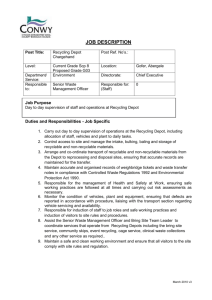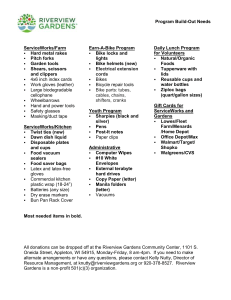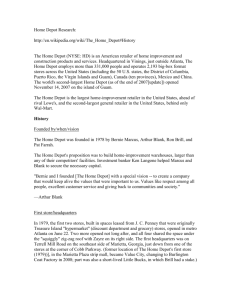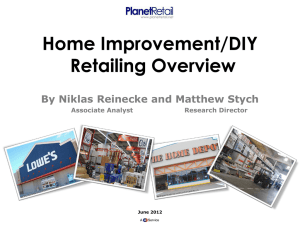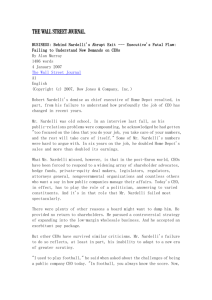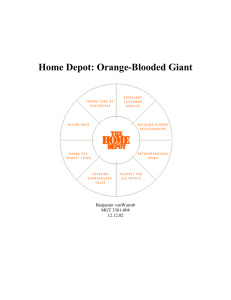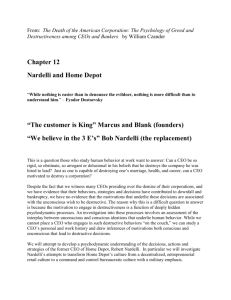NardelliRetailingAM5Text.doc
advertisement
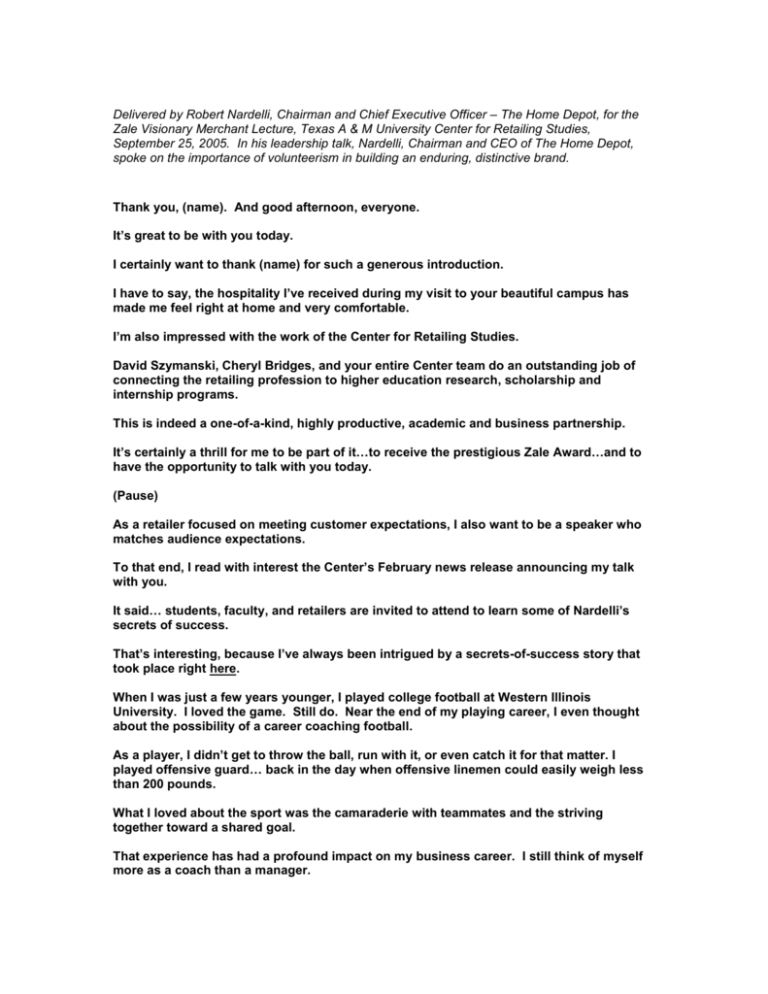
Delivered by Robert Nardelli, Chairman and Chief Executive Officer – The Home Depot, for the Zale Visionary Merchant Lecture, Texas A & M University Center for Retailing Studies, September 25, 2005. In his leadership talk, Nardelli, Chairman and CEO of The Home Depot, spoke on the importance of volunteerism in building an enduring, distinctive brand. Thank you, (name). And good afternoon, everyone. It’s great to be with you today. I certainly want to thank (name) for such a generous introduction. I have to say, the hospitality I’ve received during my visit to your beautiful campus has made me feel right at home and very comfortable. I’m also impressed with the work of the Center for Retailing Studies. David Szymanski, Cheryl Bridges, and your entire Center team do an outstanding job of connecting the retailing profession to higher education research, scholarship and internship programs. This is indeed a one-of-a-kind, highly productive, academic and business partnership. It’s certainly a thrill for me to be part of it…to receive the prestigious Zale Award…and to have the opportunity to talk with you today. (Pause) As a retailer focused on meeting customer expectations, I also want to be a speaker who matches audience expectations. To that end, I read with interest the Center’s February news release announcing my talk with you. It said… students, faculty, and retailers are invited to attend to learn some of Nardelli’s secrets of success. That’s interesting, because I’ve always been intrigued by a secrets-of-success story that took place right here. When I was just a few years younger, I played college football at Western Illinois University. I loved the game. Still do. Near the end of my playing career, I even thought about the possibility of a career coaching football. As a player, I didn’t get to throw the ball, run with it, or even catch it for that matter. I played offensive guard… back in the day when offensive linemen could easily weigh less than 200 pounds. What I loved about the sport was the camaraderie with teammates and the striving together toward a shared goal. That experience has had a profound impact on my business career. I still think of myself more as a coach than a manager. (Pause) College Station, of course, is a great football town. Aggies have even been featured in a famous Broadway play. And the Aggie team of l954 – the famous “Junction Boys” of Coach Paul “Bear” Bryant -is one of my favorite football stories. Many of you know the story. Some of you may have read the book by Jim Dent that describes the ten-day training camp that forged a championship team from one that only won a single game the season before. Of course, it was a brutal training camp in blow-torch heat. Of 111 players who started the Junction training camp, only 35 completed it. But the extraordinary bonding of those 35 who emerged made them perform like no other team in America…including teams with more gifted athletes. It’s a fascinating real-life story of perseverance, teamwork, and the capacity people have to go beyond what they think they can do. As a leader, Coach Bryant, was more than a drill sergeant. He was an innovator and visionary when it came to strategy and tactics. And he led a team of players who relentlessly executed and repeated the right things, especially when games were on the line in the fourth quarter. So as a former player and big fan of the game, it’s great to be at the place where that football history unfolded. And it never ceases to amaze me how often these qualities of passion, innovative thinking, and discipline in execution identify successful people. You see it not only in sports, but in all walks of life – whether it’s the performing arts, scientific research, or retailing. (Pause) With that in mind, I’d like to share five priorities I believe further those character traits, and that will be critical to the success of retail leaders ahead. They’ve been focal points that have driven our own recent makeover at The Home Depot. They’re more priorities than secrets. That’s the one edit I would make in the news release. So let’s call them Nardelli’s five priorities for retailing excellence. To begin, I’d like you to use your imaginations with me for a moment. Close your eyes, if you’d like. (Pause) I’d like to fast-forward you to the retail store of the future. At the entrance, imagine you’re greeted by a smiling doorman wearing a classic, stylish uniform. Once inside, you’re met by two actors posing as a young, hip, apartment dwelling couple. 2 They’re surrounded by a city skyline mural. And they’re performing a series of home improvement projects…like painting and installing a wood floor. Now, imagine moving on and passing by a series of sleek computer kiosks that help you learn how to install a faucet. As you browse, imagine seeing live, video clinics simulcast from an on-site broadcast studio. Imagine that this store’s products and services match-up with a specific set of customers, and their unique tastes and aspirations. Imagine that store uses digital age technology and logistics expertise in creative ways to enhance the shopping experience. And even imagine yourself checking-out a refrigerator for the fraternity or sorority house…or dorm room, or apartment…and up pops a human ghost…a hologram that gives you tips about the ‘fridge’s features. Sounds like something out of that Steven Spielberg film, “Minority Report,” doesn’t it? (Pause) As a matter of fact, we haven’t imagined such stores at The Home Depot; we’ve already built them. They’re our new urban stores that have recently opened in Manhattan, Vancouver, and Chicago. The art of imagining…designing…and then acting on new designs makes retailing a lot of fun. It’s a business in which you must continually challenge your assumptions. What are customers thinking? How are they shopping? How can we improve their lives at home, and their experience in our stores? I call this first priority…Innovate to Grow Fast. Some people associate innovation with a seat of the pants, act on hunches leadership style. That’s a slippery slope in today’s world. We live in an Internet Age when customers are empowered like never before. To connect with their changing expectations, retailers have got to measure customer behavior like never before. At The Home Depot, innovative ideas most often spring from our exhaustive research of customers and from market data. Then, we test those ideas out before we invest. Before we opened our Manhattan stores, for example, we did 400 telephone surveys of in-town residents, 200 interviews with local contractors, and a number of focus group studies. Research leads to ideas, which lead to testing, which leads to calculated risk-taking. 3 Once you’ve done your homework, it’s time to act. By following through on our research and testing and investing in our urban stores, we’ve successfully reached out to underserved customers and markets. We’re meeting the specific needs of an entirely new customer base. This is what I term tapping in to customer empathy. We’re connecting with a new market segment’s unspoken desires. That’s why I say…Research and Innovate To Grow Fast. (Pause) Taking innovative concepts from the drawing board to the real world leads me to my second retailing priority – Building A Human Relationships Culture. Great ideas built on solid research get you nothing without execution. And execution takes high-energy people. The number one factor in the success we’ve had at The Home Depot…from our roots 26 years ago… to today…is our people. Our employee workforce of 325,000…we call each of them associates… is the eighthlargest in corporate America. Our associates interact with customers three billion times a year. In fact, during my talk with you this afternoon, some 20,000 Home Depot customer transactions will have taken place. We ask more from our employees than most retailers. That’s because shoppers come to us as much for advice as they do for products. Our employees’ skill as home counselors is the reason we can execute on our customer promise…”You can do it; we can help.” All the value The Home Depot creates stems from our people. I believe customer and shareowner value are inseparably linked to how well leaders respect, develop, and inspire employees. A lot of companies talk about this. We are determined to show it. When we started Home Depot’s makeover in 2000, Human Relations led the way. Actually, I prefer to call it Human Relationships. That’s more descriptive of our process. Human relationships means working directly with our operations and store managers to develop leaders. We’ve created Leadership Learning Institutes that involve 23 million hours of personal development. Don’t think school is over when you receive your degree at Texas A&M. Learning how to lead involves a lifetime of learning. 4 Career education and training is how we create a pipeline of leaders who’ll drive Home Depot’s future. We’re also building relationships through talent sources like the U.S. Military. We work with the Armed Services to hire veterans. They include soldiers and officers who’ve served in the Middle East. We have another relationship with the AARP to hire seniors. We’ve learned that a lot of stereotypes about seniors slowing down don’t hold water. And we’re also cultivating a more diverse workforce. Texas is a great example of the importance of that. It’s the nation’s second most populous state… the sixth fastest growing state…and it has the third fastest-growing Hispanic population. (U.S. Census Bureau). We’re matching our associate force to the increasing diversity of the population. We’re excited about a hiring partnership we just announced last month with four of the nation’s leading Hispanic organizations. Our Human Relationships focus has even extended to helping associates compete in the Olympic Games. If we had been a country competing in the Athens Games, we would have finished 12th. Forty-six U.S. athlete-associates competed, and nine earned a total of 10 medals. Texas associate, Steven Lopez, is one of these athletes. He won Gold medals in Taekwando at the Sydney and Athens Games. All of the relationships I’ve described and more bring a lot of new talent into The Home Depot with varied skills and experiences. How do we develop their retailing skills? Much like we do in developing and refining innovative ideas, we treat people development as both an art and a science. Outstanding human relationships between organizations and individuals are the residue of outstanding design. We focus on processes and metrics in the workplace. That creates meaningful expectations that help people become accountable for the right things. And if you align systems and technology squarely behind employees, you’ll give them the tools they need to expertly repeat the right things. That’s being a good coach. (Pause) There’s yet another reason I believe people relationships are too important to leave to chance. They make possible my third priority: Building a Brand That’s More Than Business. What takes a brand beyond the well known to one that becomes part of people’s everyday vocabulary and conversation? It often involves an emotional connection, doesn’t it? 5 I’d like to show you an example of that with a video clip from the David Letterman Show. (Play Letterman Tape) That broadcast went to some five million people. You can’t buy that kind of credibility. How does it come about? How do you build an enduring, distinctive brand? One such brand is your own Texas A & M brand. One of the things that differentiates your university is its traditions. There’s “Aggie Muster” coming up in April. The annual candlelight service reminds all on campus of the Aggie spirit and camaraderie. And you can imagine that I’d like “the 12th Man” tradition where the student body stands at football games to express their willingness to don a uniform and play for the team if needed. That dates all the way back to l922. One of the traditions that identifies The Home Depot brand with being a good neighbor is a devotion to volunteerism. You see people in orange aprons at Habitat for Humanity home builds, participating in the Hands on Network, and our National Week of Service, where last year the entire workforce devoted a week to community service. During that extraordinary week last November, we donated more than 260,000 volunteer hours. And we completed more than 1,600 community service projects across the country. All told, we invest some seven million hours annually in community service through our Team Depot volunteer corps. We think volunteerism speaks volumes about who we are. But it’s bigger than our brand. I personally believe volunteerism is the single most powerful, untapped force for positive change in our country, and our world for that matter. And corporate America is ideally suited to organize that force. Think of it this way. According to the Urban Institute, a volunteer’s time is valued at $20 dollars an hour. So when 260,000 volunteer hours are devoted to community service, that’s $5.2 million dollars of value created. That’s powerful. And it’s why volunteerism is connected with most everything we do. In our marketing sponsorships, for example, we don’t hesitate to ask celebrities like Hildy of the Trading Spaces reality show… or the ESPN College Football Game Day hosts… to wield a paintbrush with us, or to help us refurbish outdated athletic facilities. And this year, our NASCAR driver, Tony Stewart, and his crew, will join Home Depot associates in cities across the country to build playgrounds for disadvantaged kids. 6 The real secret to brand building is not doing the expedient…but doing what will sustain you over time. And that involves working toward the greater good. Texas A & M’s attention to tradition makes it a University that sustains and forms lifetime bonds between university, students, and alumni. Building a brand that’s about more than business makes our business sustainable in the communities we serve. We’ve become part of those communities’ economic, social, and environmental well being. (Pause) About right now… one of the things you might be asking yourself is this is all well and good… but how are people going to find the time to do all that’s required of them today to be a sustainable business? How will employees find the time to serve their communities, their employers, their families, and their customers? After all, customers are empowered by cell phones, blackberries, and the Web. They expect a lot more from us. Gen Yers, for example, do most everything online. They follow their NCAA March Madness brackets, gather homework research from Google, buy concert tickets, and of course, shop electronically. When you’re in a store, you also want technology to work for you. You want self-checkout to move quickly. We deliver that now in more than 1,000 stores. What if you’ve got a part-time job with Home Depot? You don’t want to manually log in inventory. You want to just zap it with a scan gun. We’re making that available. Time is a precious resource in today’s world. And by making the most of time, technology can drive top and bottom-line growth. To boost our top line, Homedepot.com has helped us create a convenience innovation we call “the endless aisle.” We make 230 Kohler bath products available in-store for consumers to see and touch. Then we can make another 20,000 available by special order online or through our warehouse call center. As for the bottom-line, we’ve become a technology focused retailer to help our associates focus their time on serving customers. We’ve invested in workload management software…in centralized purchasing to combine nine buying offices into one…and in inventory tracking. All told, we’re now investing twelve times more in I-T than we did five years ago. We had 210 major technology projects in the works last year alone. 7 It’s money well spent. Because it sharpens our ability to execute…to be productive…to use time wisely. Technology has become integral to our strategic planning at Home Depot. And that brings me to my final priority…building a strategic roadmap for growth. I’ve got a suggestion for those of you who will be interviewing soon for positions with companies. Ask those companies to share their business strategy with you. That will not only impress a potential employer. But you’ll also find out a lot about that company’s direction. You don’t want to work for a company with sketchy direction. You want one with a sound, sustainable strategy. In his best-selling business book, “Good To Great,” author, Jim Collins, talked about how most great companies didn’t stray from what they do best. Those companies grew through new lines of business that were adjacent to and complementary to their core businesses. In a similar way, the executive management team at The Home Depot has developed a transformation strategy that centers around the 3E’s of enhancing our core…extending to new businesses…and expanding our markets. We will grow by continuing to enhance our core business. How? By developing innovative products, and by modernizing our stores. We’ll extend the business with our new store growth and concepts like our Manhattan stores. And we’ll expand to new geographic markets. Our growth outside the U.S. builds on what we’ve done well here. At the same time, we’ll adapt to the cultural framework of the communities we serve. Today, we have some 150 stores in Canada and Mexico. We plan to expand in those countries and to soon begin opening stores in China. Rising middle classes in developing countries like China, India, and the Americas bode well for U.S. retailers. China’s gross domestic product is growing by a remarkable seven to eight percent a year. New China housing construction is growing by 33 percent a year. China represents a $50 billion dollar annual market for home improvement. People sometimes ask me how big can Home Depot get? Well, in the U.S. there’s a $175 billion dollar market in do-it-yourself. There’s $200 billion dollars or so in installation and materials. 8 There’s nearly $300 billion in professional small repair and remodeling. There’s $200 billion or so in higher-end professional. And there’s growth potential in all these areas in places in the world we’ve never been represented. Pretty soon you’re approaching a trillion dollar market. Who knows what the limits really are? What we do know is that people around the world take immense pride and satisfaction in their homes. How can we make it more convenient, affordable, and enjoyable for them to do that? It’s an exciting prospect. (Pause) And your prospects are exciting as well. You’ll be challenged by a world that moves faster than ever. That will be your challenge. But that can also be your opportunity if you make the five priorities I’ve outlined work for you. I think we’re moving into an era of customer empathy. How can we think and connect with the technology empowered customer’s fast-changing desires and expectations? You can keep up with their unspoken desires if you are relentless about uncovering them through customer and market research…testing new ideas…and acting on them. You’ll excel at execution if you develop meaningful human relationships, and align technology behind people. You’ll build an outstanding brand by focusing on the greater good. And you’ll create growth opportunities through a strategic blueprint that expands upon your core strengths. (Pause) I wish all of you the best in your careers and business endeavors ahead. Thanks so much for joining me today, and for your attention. I’d be happy to answer any questions you might have. Who has the first question? ##### 9 10



